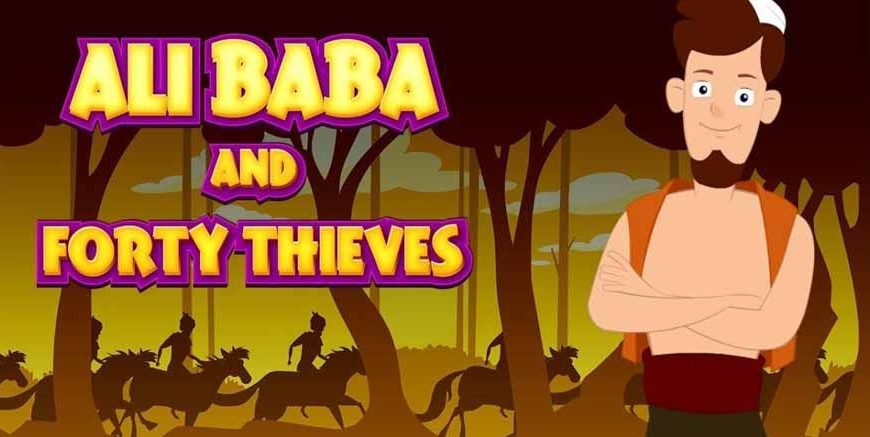Ali Baba and the Forty Thieves is a popular story from “One Thousand and One Nights,” a collection of Middle Eastern folktales written in Arabic. It is one of the evergreen stories that one would wish they were a part of. The Ali Baba story offers adventure, adrenaline, and moral lessons, making it a joyful and engaging read for kids. Moreover, it enhances your little one’s literary abilities by introducing new words, such as “sesame,” “caves,” “thieves,” and others, teaches them the power of storytelling, and more. Read ahead to know more about the Ali Baba story.
Origin and History of Ali Baba and the Forty Thieves Story
The story of Ali Baba and the Forty Thieves remains one of the most famous tales in The Thousand and One Nights to this day. Believed to have been narrated by Scheherazade to her husband, King Shahryar, the story is perhaps one of the most frequently adapted or filmed scripts in literature and theatre around the world. The main characters and dramatic events, along with the beautiful descriptions, persistently featured in the tale, make the story still popular all over the world to this day, regardless of whether it is considered Eastern or Western folklore.
Ali Baba and the Forty Thieves Short Summary
Ali Baba, a poor woodcutter, discovers a secret cave used by forty thieves to store their treasure. The cave opens with the magical phrase “Open Sesame.” Ali Baba takes some treasure, but his greedy brother, Kassim, is caught by the thieves and killed. With the help of a clever slave girl named Morgiana, Ali Baba outwits the thieves, who try multiple times to kill him and reclaim their treasure. Morgiana ultimately kills the leader of the thieves, and Ali Baba rewards her by granting her freedom and marrying her to his son.
Ali Baba and the Forty Thieves Characters
Here are the main characters of the Ali Baba and the Forty Thieves story:
- Ali Baba, a woodcutter, finds a treasure.
- Kassim, brother of Ali Baba, who gets killed by the 40 thieves.
- 40 thieves
- Morgiana, the clever maid, protects Ali Baba from the wrath of the thieves.
Story of Ali Baba and the Forty Thieves
In a small town in Persia, reside two brothers, Ali Baba and Kassim, who are polar opposites of each other. While Ali Baba is a woodcutter by profession, his brother is a merchant. One day, while working in the forest, Ali Baba witnesses a group of forty thieves accessing a secret cave by uttering the magical phrase, “Open, Sesame!” He takes time and follows the thieves and uses the same words to gain entrance into the cave, only to find an overwhelming stock of goods that had been stolen.
Ali Baba takes a small portion of the wealth home, sharing the secret with his wife. Observing Ali Baba’s changed lifestyle, his rich brother Kassim becomes jealous. He confronts Ali Baba, who reveals to him about the cave. Greed takes over Kassim, and he rushes to the secret cave.
However, he forgets the magic words to exit and is caught and killed by the returning thieves. Finally, when Ali Baba learns about his brother’s plight, he, with the help of Morgiana, an intelligent slave girl, subdues the thieves and safeguards his family.
The climax of the story arises when a rogue band of bandits, led by their clever captain, plots to exact revenge by attempting to break into the house owned by Ali Baba. By outsmarting the thieves in every possible way and devising clever tricks and strategies, Morgiana can overcome them. In the end, she slays the thieves, their master, who had disguised himself as a merchant to execute Ali Baba. So, in gratitude, Ali Baba took Morgiana, freed her, and gave her the hand of his son in marriage.
Ali Baba and the Forty Thieves Short Story:
The short version of this story contains all the features that have made it one of the most popular legends. It starts with Ali Baba’s discovery of the cave of the thieves and the secret that opened the entrance to the cave. It does not take long to introduce the audience to Ali Baba’s honesty and his wicked brother Cassim to set stage for the struggle.
In the course of the story, the climax is brought to bear on the Sophisticated efforts the Thieves make in order to get to know Ali Baba and try to take back their loot. All the times that the film failed in delivering the impression reveals that Morgiana is a smart and loyal character who does everything to safeguard her master and his loved ones.
The plot of the complex and the story is more presented in a sentimental way focused on key scenes: Ali Baba who discovers the cave, Cassim who succumbs to greediness and Morgiana who plays a trick on the thieves. These two incidents help to bring out the lessons of the story by emphasizing on the vices of greed, and the virtue of the wise and loyal.
When boiled down to its essentials, all the fun and the sermonizing is still there. Rather, it turns into a dense-threaded story that enchants people and remains in their memory for a long time. Precisely because of their length, short stories contain much more tension and drama, so the newly acquainted audience can familiarize themselves with “The Arabian Nights”.
Moral of Ali Baba and the Forty Thieves
Fundamentally, the lesson to be learned from the story of Ali Baba and the forty thieves is never to let greed get the better of you. Kassim and the forty thieves, who were greedy for the treasure, could never stay at peace.
The story also teaches kids the importance of humility. Ali Baba, despite being rich after his victory and emergence into fame, remains a humble man. On the other hand, Cassim is characterised by greed, and he ends up being killed. This side-by-side contrast of the girls is used to teach the audience not to pursue wealth excessively, as it comes with dire consequences.
Moreover, the story of Ali Baba and the Forty Thieves also emphasises the triumph of the intellect and cleverness over the physically strong brute. Morgiana, a slave girl, repeatedly outsmarts the forty thieves, demonstrating that cleverness and quick thinking are often more valuable than physical strength or numbers. This aspect of the story encourages readers to value and cultivate their intellectual abilities.
Also Read: Mahabharata Stories for Kids with Moral Lessons
Conclusion
In conclusion, it is safe to say that the story of Ali Baba and the Forty Thieves is an entertaining tale that continues to captivate and educate people from diverse parts of the globe. Its bright characters, the scope of the action, and the relevance of the moral at the base make it one of the most popular books in the world. This story from “The Arabian Nights” presents its audience with a fine blend of action, advice and the conscience that people of different cultures and ages can appreciate.
Looking for such fun and entertaining stories? Check out our blog, Fun and Exciting Disney Stories For Kids. For more such fun and exciting reads, visit EuroKids Blogs. Don’t forget to check out EuroKids Preschools for the right start to your little one’s learning journey. Click here to know everything about preschool admission.
Related Blogs:
- Talking Cave Story: The Talking Cave is a clever tale that teaches kids the value of wit and presence of mind through the story of a smart jackal who outsmarts a hungry lion. It’s a fun way to help children understand how quick thinking can solve tricky situations.
- Stories of Lord Krishna for Kids: Lord Krishna’s childhood stories compiled to introduce your children to kindness, courage, and the power of doing good.
- The King of the Jungle Story for Kids: The King of the Jungle story teaches kids about leadership, fairness, and the responsibilities of being in charge, through the wise and strong lion.
- Diwali Stories for Kids to Read: Diwali stories that help kids understand the meaning behind the festival of lights. These stories make the celebration more meaningful and joyful for young minds.
















